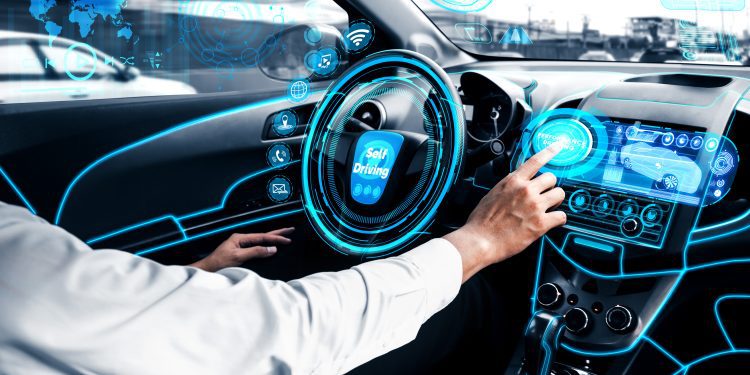The future of mobility continues to evolve at an unprecedented pace, and integrated vehicle payments are likely to play a pivotal role in redefining the driver and passenger experience. By automating and integrating the purchase and payments of services using vehicle data and connectivity, drivers will benefit from convenient and simplified experiences. This trend will eventually help increase customer usage and engagement for service providers while enabling innovative, beneficial charging models, which may favor the adoption of in-vehicle payment services in the long run.
Another factor largely contributing to the growth of the global in-vehicle services market size is the rapidly evolving digital payment landscape that gained momentum due to the expansion of traditional financial services during the pandemic.
According to the Global Findex 2021 database published by the World Bank:
- An estimated 76% of the adult population globally had an account with a mobile money provider, a bank, or any other financial institution as of 2021.
- In 2021, two out of three adults worldwide could make or receive digital payment, with around 57% of these happening across developing economies.
These estimates highlight the accelerating shift in consumer behavior and the growing need to introduce better digital payment solutions, which may carve a healthy growth trajectory for the in-vehicle payment services industry.
Autonomous EV Sales Are Driving Demand for In-Vehicle Payment Services
As consumer needs are evolving, so are the global automotive trends, resulting in the expansion of the existing fleets of electric vehicles. The new edition of the annual Global Electric Vehicle Outlook published by IEA shows that:
- Global electric car sales reached 10 million units in 2022, and could reach 14 million in 2023, exhibiting a growth of 35%.
- Electric cars’ share in the overall car market recorded a 14% growth in 2022 and may expand by another 18% in 2023.
The ongoing vehicle electrification has prompted automobile manufacturers across the globe to innovate and introduce advanced infotainment systems to align with the changing customer requirements, thus capturing a larger share in the in-vehicle payment services industry. Hyundai, for instance, rolled out its plan to launch an in-car payment system in May 2023. The system is likely to debut in the automaker’s all-electric IONIQ 5 crossover SUV, enabling drivers to find and pay for food, parking, and EV charging. The move highlights how automakers are exploring new ways to generate revenue and provide customers with features typically associated with smartphones. Such innovations will aid the adoption of digital services across the automotive space, thus creating new growth prospects for the in-vehicle payment services business.
Innovative Efforts to Expand the Application Scope of In-Vehicle Payment Services
Connected technologies have profoundly transformed the way people transact, innovate new business models, and foster new opportunities for all stakeholders across the automotive space. Industry experts predict that the introduction of digital payment services, such as car wallets, can transform the payment sector, reshape commerce and drive new shopping experiences. As customers look forward to more convenient digital solutions to spending, car dealers, tech startups, and banks are becoming willing to institute new distribution models and shopping experiences to cater to consumers’ changing needs.
To that end, in May 2021, PayByCar, Inc., an innovative transactional vehicle payment solutions provider, announced plans to expand its services at 27 Alltown Mobil gas stations across Massachusetts. The move focused on offering PayByCar customers the additional security of paying for gas and other goods directly from their mobile device, without using cash, a mobile app, or a credit card.
In another instance, in December 2022, BMW chose Parkopedia to power its in-vehicle parking payments feature, Single Sign-On (SSO). The latest feature enables drivers of BMW cars with BMW Operating Systems 7 and 8 to seamlessly pay for parking in Austria and Germany through the vehicle’s in-built infotainment system. The company has plans to further expand to other European nations this year.
Adoption of growth strategies such as these will increase the penetration of in-vehicle payment services in varied applications ranging from fueling/EV charging, automated toll payments, smart parking, and e-commerce applications, which, in consequence, will boost market revenue.
Conclusion
While improving technological landscape and changing consumer preferences are helping the market progress through the ensuing years, several strategic moves undertaken by players across the automotive and tech space are expected to pave a strong growth pathway for the in-vehicle payment services industry in the long run.
An agreement between Ford and Stripe is an instance supporting this trend. Last year, both companies signed a five-year contract to revolutionize the automotive payments and e-commerce experience. Under the agreement, Stripe will operate as a leading payment service provider for Ford and its retailers across Europe and North America. This apart, a significant rise in investments across the automobile sector will further play a critical role in accelerating the shift toward advanced technologies, thus bolstering the demand for in-vehicle payment services.










